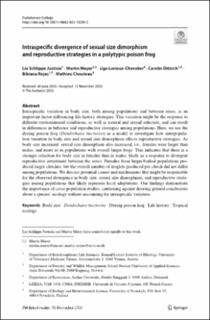Intraspecific divergence of sexual size dimorphism and reproductive strategies in a polytypic poison frog
Schlippe Justicia, Lia; Mayer, Martin; Lorioux-Chevalier, Ugo; Dittrich, Carolin; Rojas, Bibiana; Chouteau, Mathieu
Peer reviewed, Journal article
Published version
Permanent lenke
https://hdl.handle.net/11250/3110664Utgivelsesdato
2023Metadata
Vis full innførselSamlinger
Sammendrag
Intraspecifc variation in body size, both among populations and between sexes, is an important factor infuencing life-history strategies. This variation might be the response to diferent environmental conditions, as well as natural and sexual selection, and can result in diferences in behavior and reproductive strategies among populations. Here, we use the dyeing poison frog (Dendrobates tinctorius) as a model to investigate how interpopulation variation in body size and sexual size dimorphism afects reproductive strategies. As body size increased, sexual size dimorphism also increased, i.e., females were larger than
males, and more so in populations with overall larger frogs. This indicates that there is a stronger selection for body size in females than in males, likely as a response to divergent reproductive investment between the sexes. Females from larger-bodied populations pro duced larger clutches, but the overall number of froglets produced per clutch did not difer among populations. We discuss potential causes and mechanisms that might be responsible for the observed divergence in body size, sexual size dimorphism, and reproductive strategies among populations that likely represent local adaptations. Our fndings demonstrate the importance of cross-population studies, cautioning against drawing general conclusions
about a species’ ecology without accounting for intraspecifc variation.

